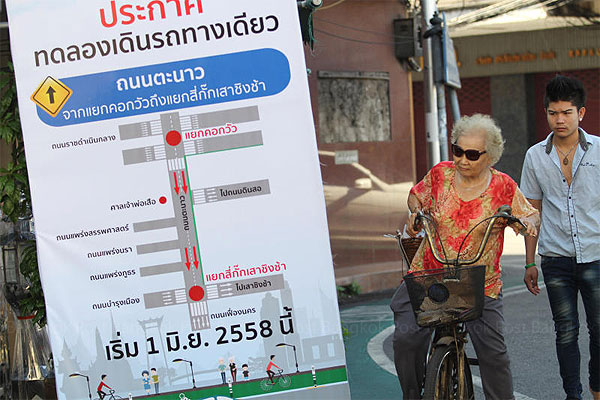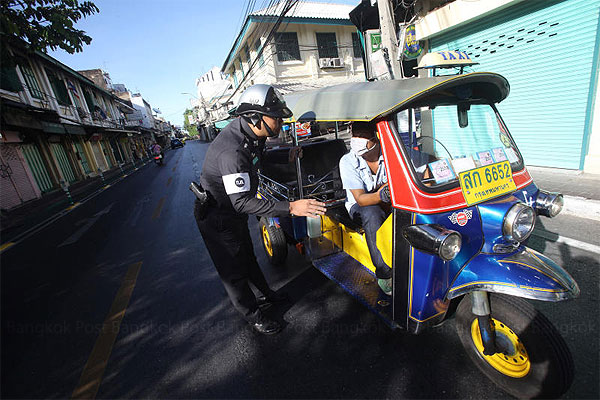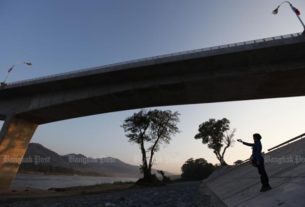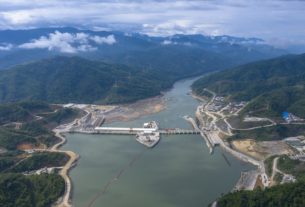Steps to end the old area’s gridlock have been enforced
Watching public buses move at a snail’s pace in the Rattanakosin neighbourhood for years, Xantharid Virochsiri always felt there could be a solution to ending the traffic gridlock in this old part of town.

New traffic measures were enforced on Monday for a 60-day trial period in the narrow streets of the Rattanakosin area. (Photos by Pornprom Satrabhaya)
So instead of just sitting back and watching the increasing number of vehicles inch through the old town, Mr Xantharid — as a member of the civic assembly called the Old Town Group — came up with ideas to ease traffic flow and improve road safety.
“Free parking spaces and long-term roadside parking in the city should be scrapped,” said Mr Xantharid, who believes fewer parking spaces will discourage motorists from driving into the inner city, including the old quarter.
Limited parking is part of a nine-point proposal that the Old Town Group has proposed to the Bangkok Metropolitan Administration (BMA) and the Metropolitan Police Bureau (MPB). The proposal is supported by the Thai Cycling Club, Health Promotion Foundation, Thai Urban Designers Association, Thai Association for Town Planning, Silpakorn University’s Faculty of Architecture Alumni Association and the cycling clubs of Thammasat and Silapakorn universities.
The proposal package was presented to the public last month at the Bangkok Art and Culture Centre where many people floated ideas and suggestions to improve traffic conditions in the city.
The data should be useful for authorities looking to work on new traffic routes. In particular, it will provide reference points for officials assigned to solve traffic congestion in busy communities, Mr Xantharid said.
The study began in February when group members inspected roads where traffic regulations would be enforced and spoke with locals who would be affected by the regulations.
The team also talked to academics to get their opinions on particular issues, he added.
City Hall and the MPB have long agonised over inner-city traffic. After reviewing the group’s proposal, they decided to adopt parts for three measures to be enforced in the old part of town.
Started on Monday, the enforced measures during a 60-day trial period aim to boost road safety and improve traffic flow on narrow streets in the area, BMA spokesperson Threedow Aphaiwongs said.
One-way traffic will be enforced on Phra Sumen Road between Bang Lamphu and the Sipsam Hang T-junction and on Tanao Road between Khok Wua and Si Kak Sao Ching Cha intersections.
Vehicle speed will be limited to 30kph on Phra Sumen, Tanao Road, Din So and Bamrung Muang roads. Parking is to be prohibited on Phra Sumen Road, between Bang Lamphu and Sip Sam Hang T-junction from 5am to 9am, and on Tanao Road from 3pm to 8pm every day, and from Kok Wua to Si Kak Sao Ching Cha from 6am to 8pm every day except Sundays.
Parking is forbidden on Tanao Road, from the Kok Wua intersection to the canal bordering Wat Mahan Pharam, the spokesperson added. Pol Maj Gen Adul Narongsak, the deputy chief of the MPB, said that the regulations will be strictly enforced and warned would-be traffic violators they will face fines during the trial period.
Mr Xantharid said the nine points include enforcing one-way traffic on Phra Sumen Road between Bang Lamphu and the Sipsam Hang T-junction and on Tanao Road between Khok Wua and Si Kak Sao Ching Cha intersections.
That plan can help improve road
safety, particularly with tourists taking in the city’s attractions around Rattanakosin Island.
“This should boost the confidence of pedestrians and cyclists riding and walking in the city as it will make them feel safer about using the roads,” he said.
A new parking area will be provided for customers wanting to shop in stores affected by the new rules, Mr Xantharid said, allaying the fears of shopkeepers that customers will not come to their shops if they are not allowed to park outside.
Another proposal is to limit the number of inbound vehicles. The MRT’s Blue Line underground route linking the old quarter to Thon Buri — the construction of which is under way — will help commuters get into the city. Private vehicles will be banned. Vehicles heading into the city will be restricted to goods vehicles, taxis and garbage trucks.
The reduction in the number of vehicles will result in lower air pollution in the area, he said.
A third proposal is to implement circulating buses that operate on set routes and schedules and run between the city main’s attractions on Rattanakosin Island and some of the popular neighbourhoods, as well as underground stations and particular spots linking to piers.
Re-arranging of tourist bus routes to ease traffic snarls around city attractions was also suggested. Tourist buses should be allowed to drop off tourists in areas between Pak Khlong Talat on Maha Rat Road and on the western side of the Grand Palace.
Meanwhile, Tha Tian Pier should be upgraded as a tourist facility and Tha Chang Pier should be reserved for city commuters. Tha Chang Pier is always busy so people are urged to use Tha Tian for their safety, Mr Xantharid said.
More cycling routes and footpaths need to be added. The group proposed route extensions to connect to subway stations, a proposal which is now under way.
To try to appeal to the better nature of motorcyclists, drivers, cyclists and pedestrians, the group proposed a campaign to urge them to treat the roads as shared spaces and to take personal responsibility for their own safety. Pedestrians, the most vulnerable group among road users, should be the priority when it comes to road usage, Mr Xantharid said.
Next is to promote well-designed city roads which would make traffic flow easier.
The group also plans to conduct for a trial period changes in traffic flow and to allow the public to voice their concerns about the changes and make suggestions.
Finally, the group sought to raise public awareness about cyclists and pedestrians and seek their help in solving traffic congestion.
Mr Xantharid said some roads, including those leading to Soi Leap Khlong Lod, Phra Lan Road and other roads linking inner-city areas, should occasionally be closed and reserved for pedestrians only, he added.
Mr Xantharid said the Old City Group’s ideas are aimed at decreasing road accidents, including those involving pedestrians and motorists, and helping to relieve traffic congestion in inner-city areas where streets are narrow.
Its proposal also draws attention to two-wheeled commuters and the use of bicycles as a basic means of transportation in the city.
Tanawat Kachacheewa, a resident living on Tanao Road, doubted if the three measures that were enforced from Monday will be practical for the area. “Old habits die hard,” he said, saying traffic in the area had always been a huge mess.
He urged the campaigners to spread the word about the new regulations and have police officers stationed at intersections to be on the lookout for people who do not comply.
“Enforcing the regulations may not be the only answer to make the plan tangible. We all have to be a part of the game,” he said.

Police officers will be on hand during the trial period to redirect traffic and enforce new measures to alleviate the build-up of vehicles in the Rattanakosin area.
Source: http://www.bangkokpost.com/news/special-reports/584073/taming-rattanakosin-dense-traffic



